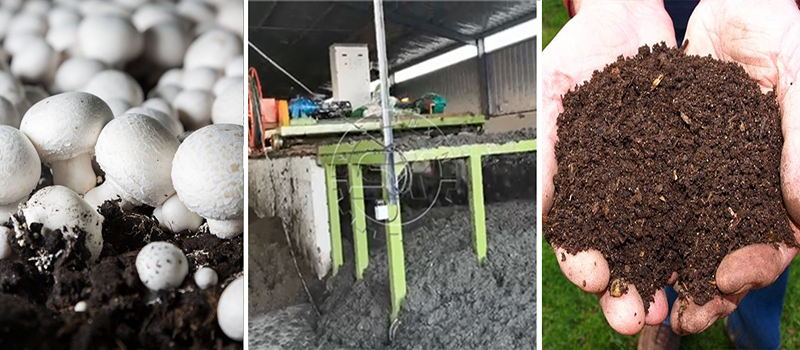Spent mushroom substrate (SMS), is the leftover material from the cultivation of mushrooms. It can be repurposed into a valuable fertilizer or soil conditioner. Here’s how you can turn spent mushroom substrate into fertilizer:
Materials and Equipment:
Spent mushroom substrate (SMS)
Composting machine
Water source
Organic matter (optional)
pH testing kit (optional)
Steps:
Collection and Handling:
Collect the spent mushroom substrate from your mushroom cultivation operation. Ensure it’s free of contaminants and other unwanted materials.
Assess pH Level (Optional):
Check the pH level of the spent mushroom substrate. It should ideally be close to neutral (pH 7) or slightly acidic. If it’s too acidic, you may need to adjust the pH by adding lime. If it’s too alkaline, you can lower the pH by adding organic matter, such as composted leaves or peat moss.Then you can make better mushroom waste fertilizer.
Adequate Moisture:
Ensure the compost pile remains consistently moist, similar to a wrung-out sponge. Regularly water the pile as needed to maintain this moisture level. We can privide you spent mushroom disposal machine with water tank.
Aeration:
Turn the compost pile regularly (about once a week) to provide aeration and help break down the materials. At that time, a professional compost machine is greately helpful for you. Click here to learn more.
Composting Time:
Naturally, the composting process of mushroom waste can take several months to a year, depending on various factors such as temperature, moisture, and the size of the compost pile. Monitor the pile’s temperature, which should rise during the initial stages of decomposition. But with suitable compost machine, you can compost mushroom waste absolutely with in about 20 days.
Curing (Optional):
Once the composting process is complete, you can allow the compost to cure for a few weeks to several months. This helps stabilize the compost and ensures that any remaining harmful pathogens are deactivated.
Quality Assessment:
Before using the compost as a fertilizer, assess its quality. It should be dark and crumbly, with an earthy smell. It should also be free of any moldy or unpleasant odors.
Application as Fertilizer:
Spent mushroom substrate compost can be used as a soil conditioner and fertilizer in various ways:
Mix it into garden soil or potting mix to improve soil structure and nutrient content.
Apply it as a top dressing around existing plants or as a mulch.
Use it in vegetable gardens, flower beds, or potted plants.
Follow recommended application rates and guidelines based on your specific plants and soil conditions.
Storage:
Store any excess compost in a dry, covered area to prevent it from becoming overly moist or contaminated.
By following these steps, you can repurpose spent mushroom substrate into a valuable organic fertilizer and soil conditioner, enhancing the nutrient content and overall health of your garden soil. If you dispose of spent mushromm substrate for commercially purposes, you can visit https://www.manuremanagementplan.com/what-to-do-with-spent-mushroom-substrate/ for details and machines.


